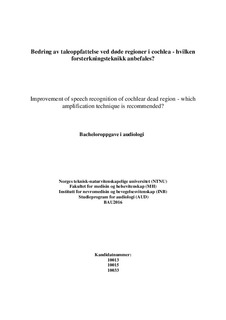| dc.contributor.advisor | Lello, Eline | |
| dc.contributor.author | Geosi, Ayah | |
| dc.contributor.author | Ingstad, Kristi | |
| dc.contributor.author | Tveit, Linn | |
| dc.date.accessioned | 2019-09-06T14:03:17Z | |
| dc.date.available | 2019-09-06T14:03:17Z | |
| dc.date.issued | 2019 | |
| dc.identifier.uri | http://hdl.handle.net/11250/2613271 | |
| dc.description.abstract | Målsettingen med denne oppgaven er å finne ut hvilken forsterkningsteknikk som gir best taleforståelse hos personer med døde regioner. Vår problemstilling lyder som følger: “Hvordan påvirkes taleoppfattelsen til personer med høyfrekvent døde regioner i cochlea ved bruk av ulike forsterkningsteknikker?”. Definisjonen på en død region i cochlea er et område på basilarmembranen hvor de indre hårcellene har veldig svekket funksjon, eller at området er ikke fungerende (Moore, 2004, s. 98).
For å komme frem til svar på problemstillingen ser man tilbake på tidligere forskning som er gjennomført i tidsrommet 2003-2019. De artiklene vi har valgt som mest relevant for vår problemstilling er fagfellevurdert og hentet inn fra databaser slik som Oria, Web of science, PubMed og Scopus. Søkeord som ble brukt var “cochlear dead region*”, “speech perception”, “speech recognition, hearing aid*”, “transposition”, “frequency compression”, “frequency lowering” og “hearing amplification”. Etter at funnene fra disse søkeordene var bedømt på enten tittel, sammendrag eller fulltekst, satt man igjen med tolv artikler som ble basen til denne oppgaven. De tolv artiklene omhandler tre forskjellige forsterkningsteknikker. 8 av disse artiklene tar for seg generell forsterkning, 3 artikler tar for seg frekvenstransportering og 2 artikler tar for seg frekvenskompresjon.
Konklusjon er at de fleste voksne med døde regioner har nytte av generell forsterkning på lik linje som andre, med unntak av personer som har døde regioner som omfatter 3 eller flere tester av frekvenser når det ble testet taleforståelse i stille omgivelser. Under testing av taleforståelse i støy fikk personer med døde regioner mindre nytte av forsterkning enn de uten døde regioner, men de opplevde ikke forverring. Resultatene hos barn er splittet hvor en forskning konkluderte med at barn har nytte av forsterkning i de døde regionene, mens en annen viser at ved å forsterke inn i den døde regionen, blir taleoppfattelsen dårligere. Resultatene fra testene når det kommer til frekvenskompresjon og frekvenstransportering viser at enkelte opplevde noe bedring i taleoppfattelse, men hos mange var det ikke en signifikant forbedring. | |
| dc.description.abstract | The purpose of this thesis is to find which amplification technique gives the best speech recognition for people with dead regions. Our founding thesis question was as follows:
“How is the perception of speech in patients with dead regions in the cochlea through use of various enhancement techniques?” The definition of a dead region in the cochlea is an area of the basilar membrane where the inner hair cells has an impaired function, or that the area itself does not work properly (Moore, 2004, s. 98).
To find an answer of our thesis question we had to look at earlier research held and published in the timeframe between 2003 and 2019. The articles we have chosen as the most relevant for our thesis question is assessed by peers, and they were gathered from databases such as Oria, Web of Science, PubMed and Scopus. Keywords used were “cochlear dead region*”, “speech perception”, “speech recognition”, “hearing aid*”, “transposition”, “frequency compression”, “frequency lowering” and “hearing amplification”. The search results were then assessed based on title, abstract or full text, and we were left with twelve results that became the foundation of this thesis paper. The twelve papers focus on three different amplification techniques. 8 of these papers revolves around general amplification, 3 papers focus on frequency transportation, and 2 papers focus on frequency compression.
Our conclusion is that most adults with dead regions will benefit of a general amplification like other patients, with the exceptions of patients that has dead regions that comprise three or more tests frequencies during testing of speech recognition in silent surroundings. During testing of speech understanding with surrounding noise, patients with dead regions had less benefit to gain from amplification than those without dead regions, but they did not experience a worsened state of hearing. The results found in adolescent patients is split as one study concluded that children benefit from amplification in the dead regions, while another show that through an amplification of the dead region, the speech recognition will be diminished as a result. The results of the tests in terms of frequency compression and frequency transportation shows that some patients experienced an improvement in speech recognition, while many patients experienced no significant increase of speech recognition. | |
| dc.language | nob | |
| dc.publisher | NTNU | |
| dc.title | Bedring av taleoppfattelse ved døde regioner i cochlea - hvilken forsterkningsteknikk anbefales? | |
| dc.type | Bachelor thesis | |
